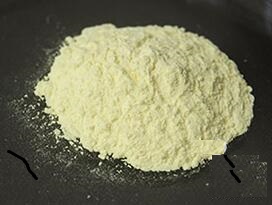| Identification | More | [Name]
Indium oxide | [CAS]
1312-43-2 | [Synonyms]
diindium trioxide
INDIUM(+3)OXIDE
INDIUM(III) OXIDE
INDIUM SESQUIOXIDE
In2-O3
india
Indium oxide (In2O3)
Indium(II) oxide
indiumoxide(in2o3)
indiumtrioxide
INDIUM(III) OXIDE, NANOPOWDER, <50NM, 99.9% METALS BASIS
INDIUM(III) OXIDE, 99.99%
INDIUM(III) OXIDE, 99.999% METALS BASIS
Indium(Iii)Oxide99.999%
Indium(III) oxide, 99.9%
INDIUM OXIDE, 99.9%
INDIUM OXIDE, 99.99%
Indium (Ⅲ) oxide
Indium(III)oxide(99.999%-In)PURATREM
indium(iii) oxide, puratronic | [EINECS(EC#)]
215-193-9 | [Molecular Formula]
In2O3 | [MDL Number]
MFCD00011060 | [Molecular Weight]
277.63 | [MOL File]
1312-43-2.mol |
| Chemical Properties | Back Directory | [Appearance]
light green powder | [Melting point ]
2000°C | [density ]
7.18 g/mL at 25 °C(lit.)
| [vapor pressure ]
<0.01 mm Hg ( 25 °C)
| [Fp ]
13°(55°F) | [storage temp. ]
no restrictions. | [solubility ]
Soluble in hexane and toluene. Insoluble in alcohols | [form ]
nanopowder
| [color ]
Yellow | [Specific Gravity]
7.179 | [Stability:]
Stable. Not flammable. Incompatible with acids. | [Water Solubility ]
Insoluble in water. | [Crystal Structure]
Sc2O3 type | [crystal system]
Cube | [Merck ]
14,4952 | [Space group]
Ia3 | [Lattice constant]
| a/nm | b/nm | c/nm | α/o | β/o | γ/o | V/nm3 | | 1.0117 | 1.0117 | 1.0117 | 90 | 90 | 90 | 1.0355 |
| [Exposure limits]
ACGIH: TWA 0.1 mg/m3
NIOSH: TWA 0.1 mg/m3 | [CAS DataBase Reference]
1312-43-2(CAS DataBase Reference) | [NIST Chemistry Reference]
indium(III) oxide(1312-43-2) | [EPA Substance Registry System]
1312-43-2(EPA Substance) |
| Safety Data | Back Directory | [Hazard Codes ]
Xi | [Risk Statements ]
R36/37/38:Irritating to eyes, respiratory system and skin . | [Safety Statements ]
S26:In case of contact with eyes, rinse immediately with plenty of water and seek medical advice .
S36:Wear suitable protective clothing . | [RIDADR ]
UN1993 | [WGK Germany ]
3
| [RTECS ]
NL1770000
| [TSCA ]
Yes | [HazardClass ]
3 | [PackingGroup ]
II | [HS Code ]
28259090 |
| Hazard Information | Back Directory | [Hazard]
See indium. | [Chemical Properties]
light green powder | [Physical properties]
Light-yellow powder; cubic crystal; occurs in both amorphous and crys-talline forms; pale-yellow amorphous form converts to crystalline form onheating at higher temperatures; isomorphous with hematite, Fe2O3; density7.18 g/cm3; melts around 2,000°C; insoluble in water; amorphous form dis-solves readily in mineral acids; crystalline form has low solubility in acids. | [Uses]
In glass manufacture. | [Uses]
Indium trioxide is used in specialty glass production. | [Preparation]
Indium trioxide may be obtained by heating indium in air or oxygen:
4In + 3O2 → 2In2O3
or by calcination of indium hydroxide, nitrate, or carbonate at elevated tem-peratures:
2In(OH)3 → In2O3 + 3H2O
In2(CO3)3 →In2O3 + 3CO2
| [reaction suitability]
reagent type: catalyst
core: indium | [Purification Methods]
Wash it with H2O and dry it below 850o. It volatilises at 850o and dissolves in hot mineral acids to form salts. Store it away from light because it darkens due to the formation of free In. |
| Questions And Answer | Back Directory | [General Description]
Indium oxide (also known as indium sesquioxide, or In2O3) is a yellow colored powder. It is a stable ceramic-like material that is insoluble in water. Indium oxide is an n-type semiconductor and thus can be used as a resistive element in integrated circuits. It also is used to form heterojunctions with materials like p-InP, n-GaAs, n-Si, and other semiconductors.
Other applications include glass (as a color additive), alkaline batteries (to suppress gas formation), and high current electrical switches and contacts (as an anti-arcing additive).
 |
|
|